Whether it’s to track a second time zone, a love of aviation history, or simply the aesthetics of a fourth hand, most collectors consider acquiring a GMT watch at least once. However, finding the best GMT watch that fits your style and budget can be difficult. Trust me, I’ve been reviewing watches professionally since 2016 and in that time I’ve tested GMTs that were either too derivative of other classic designs or overdesigned to the point of being needlessly complex and visually clunky. But what I have noticed most is that many of the watches in this category struggle to execute two very specific facets of GMTs: price and wearability. That’s why I’ve created this comprehensive breakdown of my favorite GMT watches that I’ve tested and reviewed to date.
Seiko 5 GMT SSK025 (Field Series)
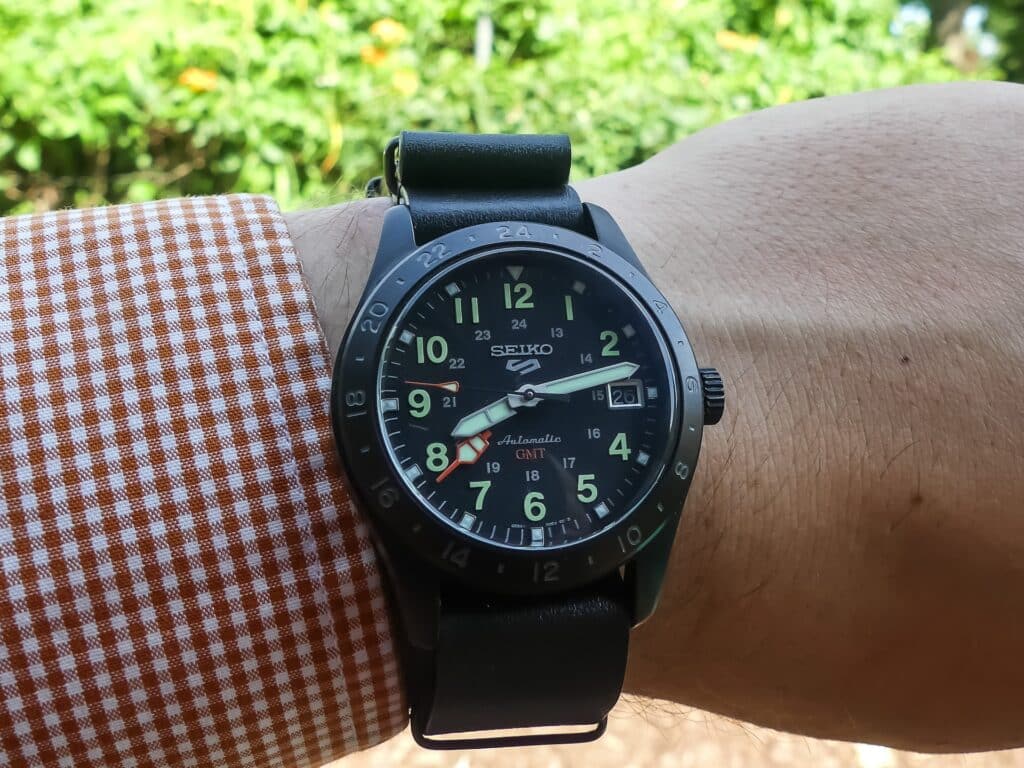
| Case Size: | 39.4mm x 47.9mm x 13.6mm |
| Movement: | Seiko 4R34 (Mechanical) |
| GMT Type: | Caller GMT |
| Crystal: | Seiko Hardlex |
| Band Options: | Single-Pass Leather Strap |
| Price: | $415 |
Truthfully, we found that wearing the SSK025 was a lesson in compromise. But a compromise that was totally worth it. Its 13.6mm thickness creates a top-heavy feel that leather and nylon straps can’t quite balance. A rubber strap, though, transforms the experience by reducing bulk and providing extra grip, making the watch far more enjoyable.
Despite its rugged appearance, the SSK025 feels more at home in an office than on an outdoor adventure, where its bulkier proportions and push-pull crown feel less dependable. The dial design is truly what saves this watch though and makes it a great contender for our list here.
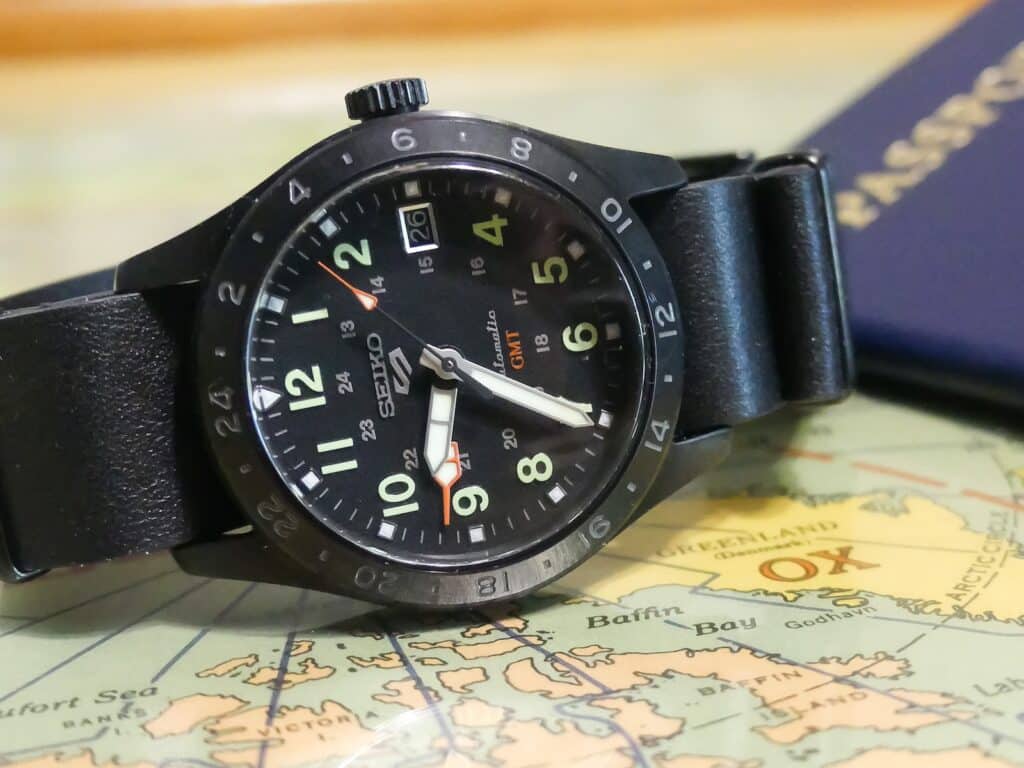
What saves the Seiko SSK025 and the reason why we’re including it in our list is the dial. While it doesn’t offer the premium features of a true GMT or the best value compared to microbrand competitors, its dial is one of the most practical we’ve ever seen. The orange GMT hands, bold numerals, balanced 12 and 24 hour dial scales are more than just aesthetic choices. They’re functional inclusions arranged in a balanced and artful way that embody the ideals of the GMT watch design.
If you like the price tag on the Seiko SSK025 GMT but aren’t totally in love with the design, you could consider the Islander Melville priced at $269, which features a less rugged inspired dial design and something a bit more modern. Be sure to visit the official Seiko site and also keep an eye on the product’s Amazon listing to compare prices against the manufacturer. If you’re interested in seeing more photos and reading more insights, we have a full hands-on review.
Seiko 5 GMT SSK005 (SKX Series)
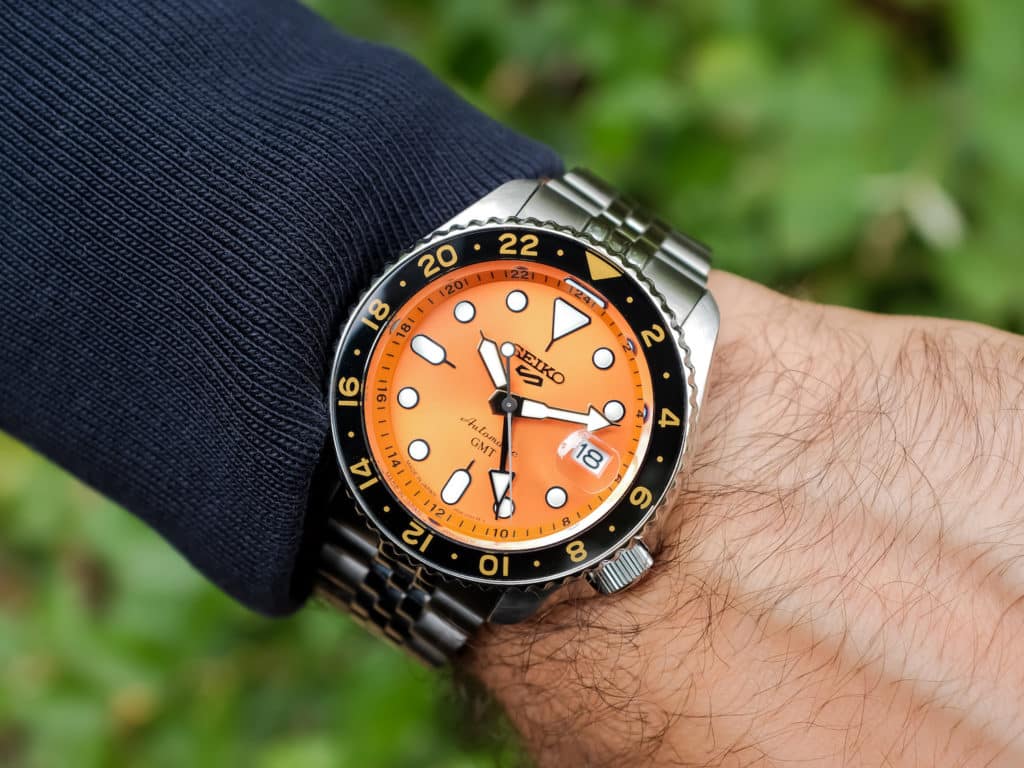
| Case Size: | 42.5mm x 46mm x 13.6 |
| Movement: | Seiko 4R34 (Mechanical) |
| GMT Type: | Caller GMT |
| Crystal: | Seiko Hardlex |
| Band Options: | Stainless Steel Bracelet |
| Price: | $475 |
I have been lackluster on many of the Seiko 5 changes that have occurred over the past several years. But the release of the Seiko 5 GMT in 2022 pleasantly surprised us. Building on the format of the iconic Seiko SKX case, the Seiko 5 GMT features a somewhat asymmetrical case shape with the crown position at 4 o’clock. At 42.5mm and 46mm lug to lug, the specs may appear on the larger side (especially compared to some of the other watches we’re discussing), but the case design itself allows the Seiko 5 GMT to wear much smaller than the dimensions on paper would lead you to believe.
Seiko specifically created the 4R34 movement for this watch release, and while these initial offerings included three dial options, we should expect to see more dial colors over time. For now, the orange, black, and blue dials certainly cover many bases, though, and most people should be able to find a model they enjoy.
I’ve spent an extensive amount of time with the original SKX007 (as well as the previous generation 7002) and I found in my personal time with the Seiko 5 GMT that the watch is just as rugged and reliable as the previous iterations. Some may feel that the reduced water resistance of 100m (down from 200m) and the lack of a screw-down crown may be cons to the watch. However, I felt no difference in the reliability and dependability of the timepiece’s construction while I tested it.
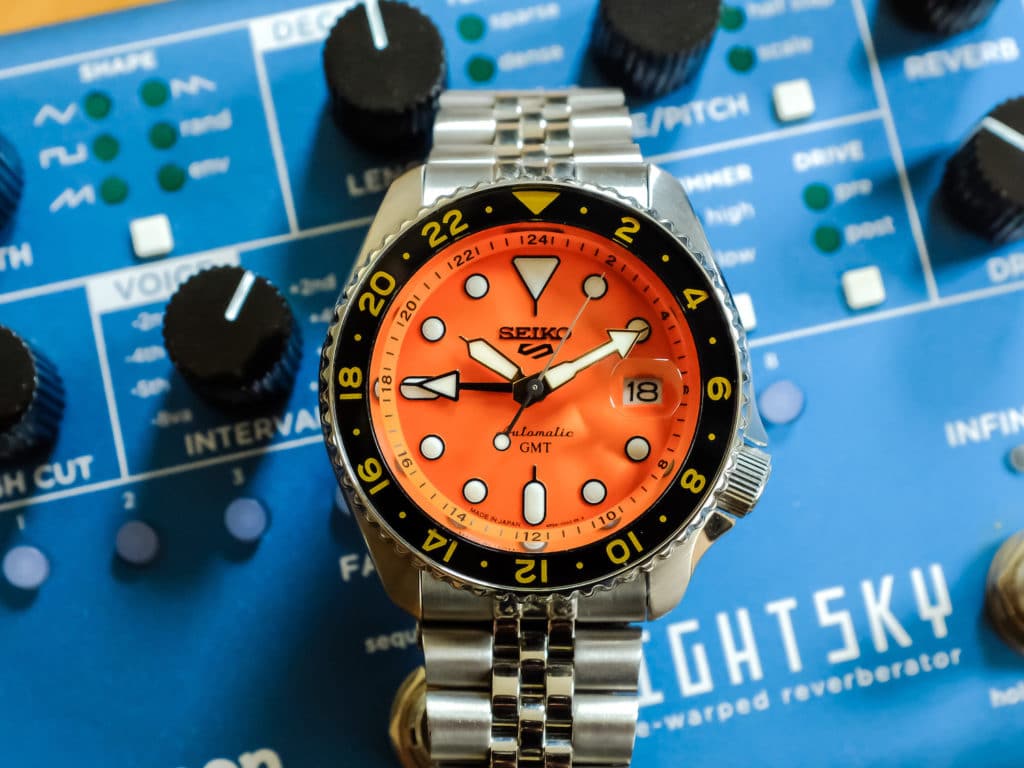
In terms of this price point there aren’t many competitors except the Steinhart Ocean 39 GMT (the next watch in our discussion), which will give you more of a classic dive watch design rather than this unique Seiko design DNA. You could also consider the Phoibos Wave Master GMT. It hits a lot of similar key features of the Seiko 5 GMT but while also being smaller in diameter at 39.5mm, which is great if the Seiko’s 42.5mm diameter may be too large for your wrist size.
The Seiko 5 GMT would be an excellent choice for someone at this price point who was looking for a more sporty GMT watch that also had a slightly vintage/retro vibe to it (being heavily influenced by the SKX case, the design of that case is rooted Seiko dive watches from the 80s).
Want to read more? Check out our hands-on Seiko 5 GMT review! You can also compare pricing between the Amazon listing and the official Seiko USA website to find the best deal.
Steinhart Ocean 39 GMT
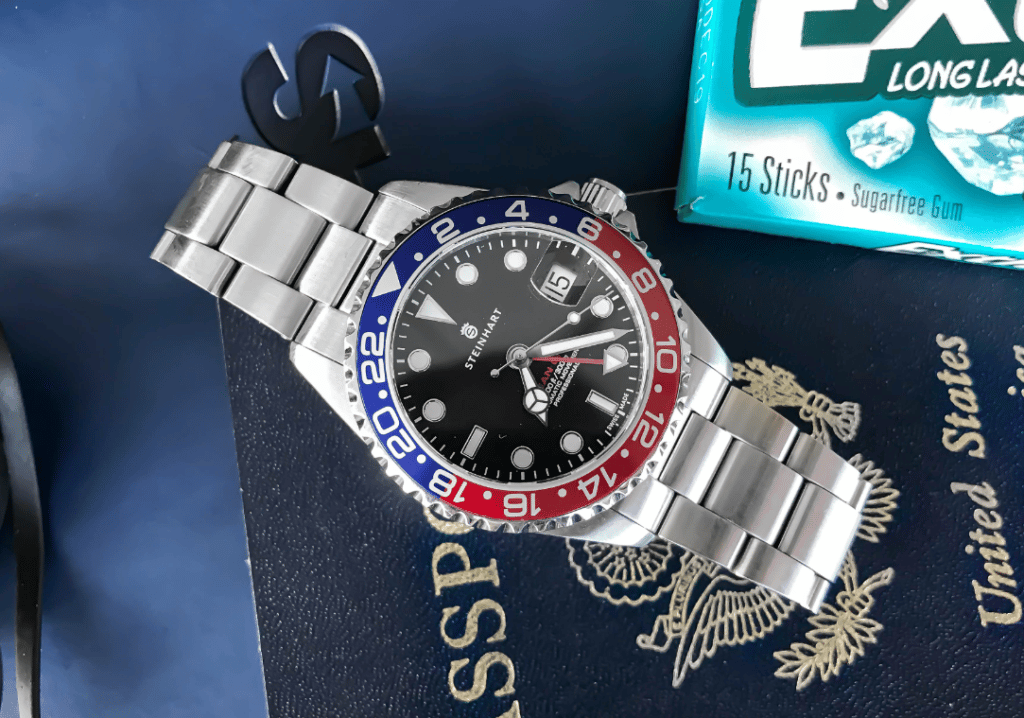
| Case Size: | 39mm x 47mm x 13mm |
| Movement: | ETA 2893-2 or Sellita SW330 (Mechanical) |
| GMT Type: | Caller GMT |
| Crystal: | Sapphire Crystal |
| Band Options: | Stainless Steel Bracelet |
| Price: | $550 – $700 |
Based in Germany, Steinhart has earned its place in many watch collectors’ hearts as a well-built, reliable, and affordable timepiece provider. Steinhart assembled their timepieces from high-quality Swiss-made parts while applying their keen eye and craftsmanship to ensure that all watches feature a tight fit and finish. Of all the models they offer, the Ocean 39 GMT is one of the most popular.
The Steinhart Ocean 39 collection is a core offering from the brand. While originally featuring classic designs of standard 3 handers for many years, in 2018 the brand released the Steinhart Ocean 39 GMT. Quite simply, in the whole catalog of Ocean 39 pieces, it simply swaps in a mechanical GMT movement and changes the dive bezel out for a 24 hour bezel insert.
The watch presents itself as another (amongst many) entry into the wide world of Rolex GMT Master homages. What sets this watch apart is the lengths Steinhart goes to ensure their legacy for high-quality construction carries through to the final product. This watch would be ideal for someone who wanted something relatively under the radar and well-built that featured the classic black dial Rolex GMT-Master II Pepsi bezel look (initially created for Pan Am pilots in the mid-1950s). It’s even available with some ceramic bezel options.
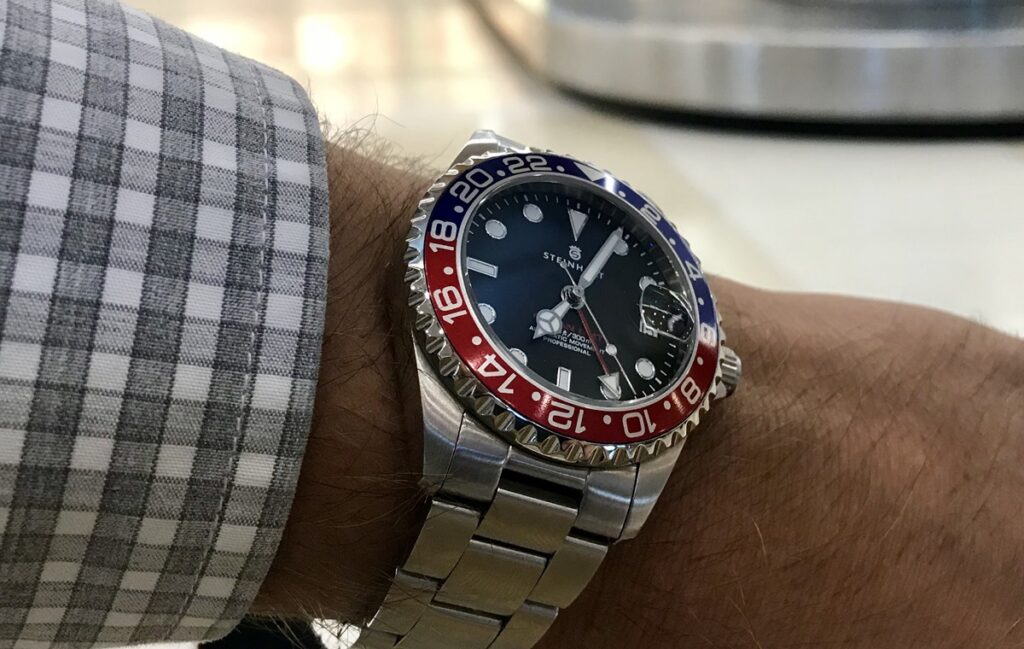
At a very wearable 39mm in diameter, 47mm lug to lug, and 13mm in thickness, the Steinhart presents itself as an ideal option for someone with a small to medium size wrist like myself. This is as opposed to other GMT Master homages like the Invicta Prodiver GMT (40953), which is much larger at 43mm, making it more suitable for larger wrists.
Powered by the ETA 2893 or the Sellita SW330, you can count on the time-honored reliability of both movements since they are equally well respected in the watch community (and feature the same specs). Plus, with 300m of water resistance, this is a sporty GMT that you can actually dive with – unlike the Q Timex GMT which features a similar Pepsi style dial and bezel design but is only rated to 50m of water resistance.
One of the largest points of criticism that the Ocean 39 GMT (and most Steinhart pieces) receive is that it’s technically not an original design, it’s an homage. For some this is absolutely a con as some people would feel odd wearing a non-original design.
However, if you have no issue with homages then I can definitively state that after wearing countless homage and microbrand pieces that attempt to riff on the GMT Master design, no other brand comes as close to offering this level of quality for the price.
You can learn more from our full, hands-on review of the watch. Plus, you also have multiple buying options if you’re interesting in picking up this piece. You can check the official Steinhart website or you can also purchase through the trusted online retailer Gnomon Watches.
Sangin Professional
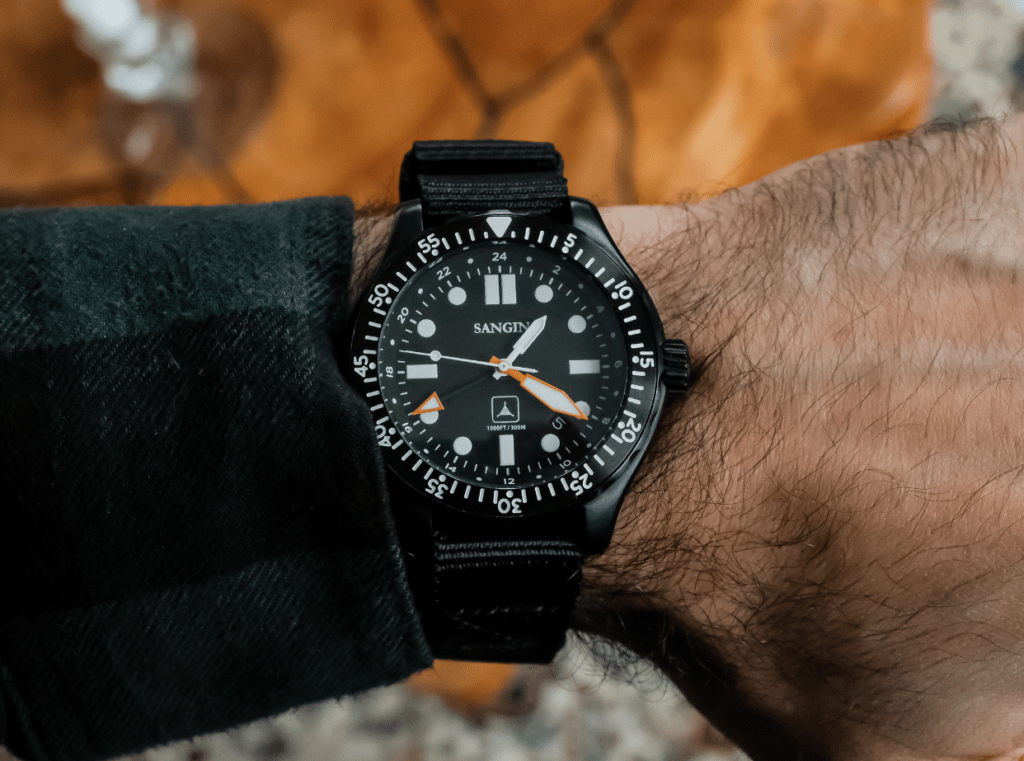
| Case Size: | 43.5mm x 49.5mm x 12mm |
| Movement: | Swiss Ronda 515.24H (Quartz) |
| GMT Type: | Caller GMT |
| Crystal: | Sapphire Crystal |
| Band Options: | Rubber strap and Nylon strap |
| Price: | $659 |
A collection of members from the enlisted forces and special operations community formed Sangin Instruments. The goal was to create purpose-driven, high-quality timepieces that represented what they felt was special about their unique journeys through the armed forces. But more importantly, they wanted to offer those watches to those who also found their journeys while enlisted.
Outside of the symbolism of the brand’s impetus and crafting ethos, the timepieces at their core feature engineering that allows them to be long-lasting and rugged – these watches are intended to function reliably in the field and real-world situations.
As such, the intended function of each timepiece influences its form – such is the case with the Sangin Professional GMT watch. Originally designed as a testing platform for another release (the Kinetic II), the Sangin Professional features a more streamline design than its future iteration. As such, this would be an excellent fit for anyone who wanted a timepiece with the robust reliability you can expect from Sangin but also something that wouldn’t necessarily look too “tactical” and out of place in an office or boardroom setting.
The Swiss Ronda 515.24H movement is a highly regarded competitor to the other comparable Swiss quartz GMT movements. The movement utilizes the well-known Ronda 515 movement as a base and adds a GMT complication to the base movement. As such, it is a reliable GMT because it’s quartz-powered, meaning it uses a battery and will, more often than not, be more accurate than mechanical movements.
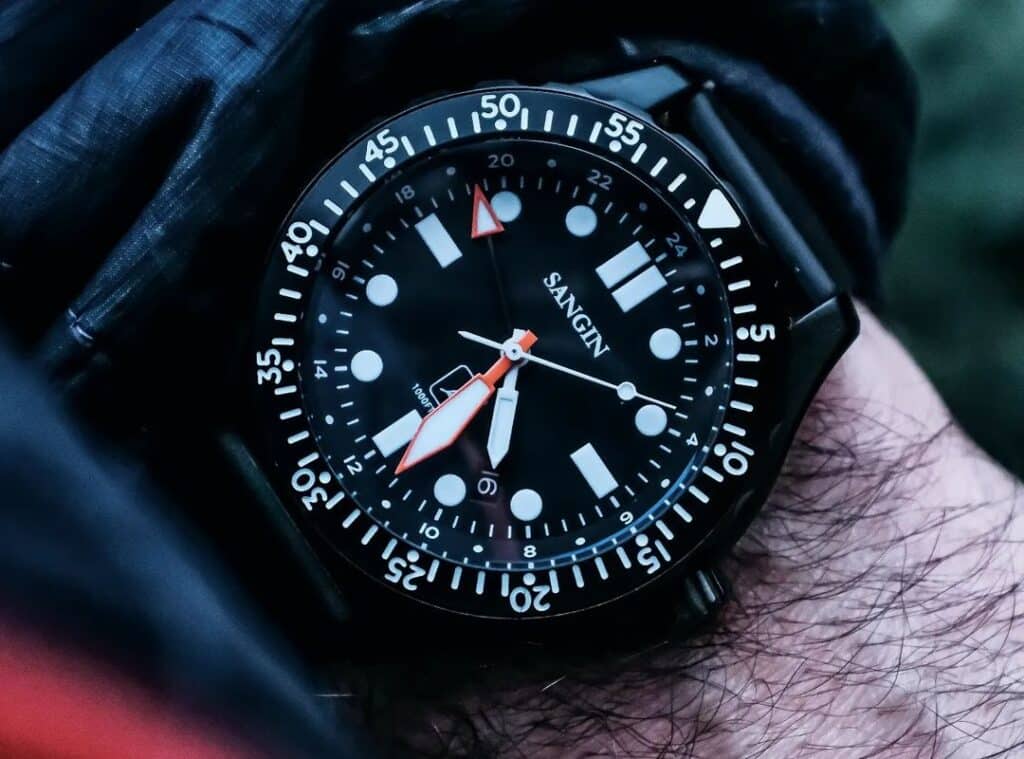
I was able to put the Sangin Professional through its paces on a combination of non-strenuous activities (like working on my laptop) and outdoor activities like hiking in brutal heat. What struck me most was just how ergonomically the watch sat on my wrist while also feeling incredibly durable (and highly legible). A lot of this is due to the watch’s dimensions. The quartz movement allows the watch to stay relatively thin at 12mm while the 43.5mm diameter and 49mm lug to lug measurements occupied enough of my 6.75 inch wrist to feel secure.
After spending time with the Professional and really getting to know the brand and their following, one of the more interesting cons that I would like to share is simply around availability. These Sangin models sell out quite fast, but it’s understandable as to why. They have a fervent following due to their ties to enlisted forces as well as the incredibly high build quality they are known for. So if there is a Sangin model or generation that you like, I would highly encourage you to make sure you stay on top of the releases so you are able to snag one.
If you’re looking for something that wears similarly but features a more tactical design, you could always look to this watch’s successor, the Kinetic II. Or if you perhaps enjoy some of the bold dial elements but would prefer something automatic, I would highly encourage you to explore the Gavox Avidiver II GMT, a dual crown, compressor style dive watch with a GMT complication.
A brand that actually has timepieces on the wrists of enlisted soldiers, an incredible build quality to endure whatever is thrown at it, and the ability to be both incredibly well-built but balanced on the wrist are why I would highly recommend this GMT. If you’re interested in learning more and potentially picking one of these timepieces up for yourself, the official Sangin website is the best place to do so.
Glycine Airman No.1
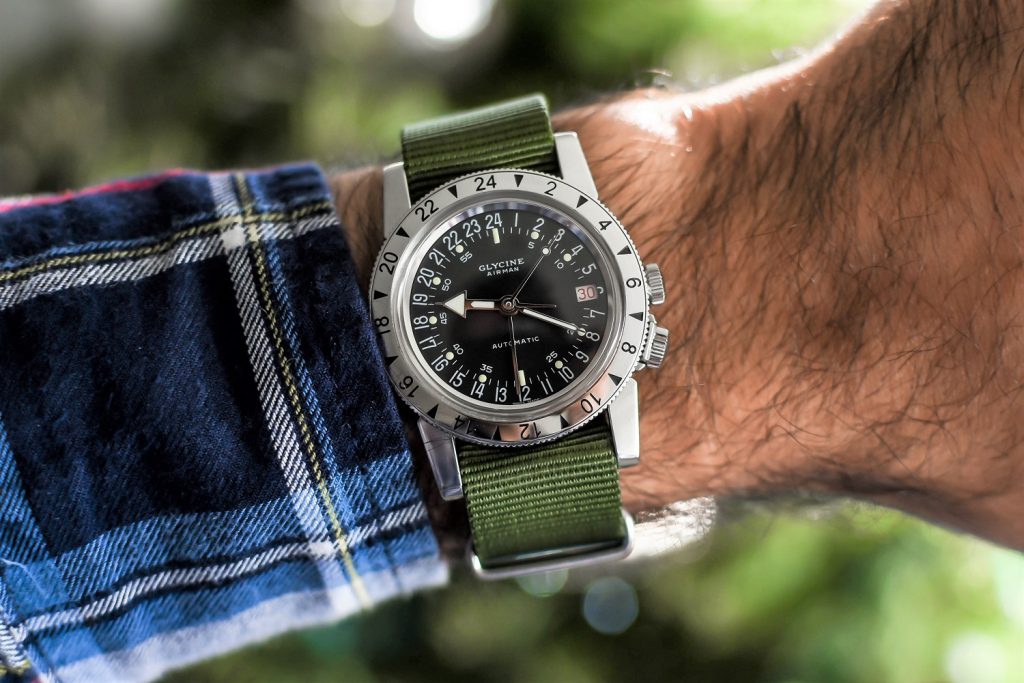
| Case Size: | 36mm x 44mm x 11.6mm |
| Movement: | Glycine GL293 (Mechanical) |
| GMT Type: | Caller GMT |
| Crystal: | Sapphire Crystal |
| Band Options: | Leather Strap (pictured on 3rd party nylon strap) |
| Price: | $970 |
Modern Glycine is a brand currently in an odd spot. Their origins start in Switzerland back in 1914. While the company’s original offerings were more geared toward jewelry-focused horology, they became synonymous with function-driven Pilot watches in the 1950s. No other watch embodies this more than the Glycine Airman No.1 GMT watch.
At 36mm in diameter and 44mm lug to lug, the wearing experience of the first Airman release is preserved very well in the modern iteration of the watch. While testing the watch, it took me some time to adjust to the size of the dial as it is quite small, which can impact dial legibility. Plus the dial is also just a bit too busy given the size – between the hour, minute, seconds, and GMT hands as well as the interior seconds track and the GMT bezel, it’s very easy for your eye to get lost when trying to read the time (which is probably the biggest con of this watch).But after a day or so of wearing it, my eyes were able to adjust. However, if you prefer something larger and more legible at first glance, that’s something to be aware of with this model.
I also found that the watch’s dimensions give it a slight sense of being visually lug-heavy while on my wrist, but that helps to balance and draw focus towards the dial, which as I mentioned can use all the help it can get in terms of being more legible. What’s interesting is that these attributes which I found to be hurting legibility while testing the watch are also exactly what makes the Glycine Airman No.1 so special. It is most likely the most faithfully reproduced vintage reissue timepiece available today. It is nearly identical to its original design, which can be very difficult to find these days as brands are always trying to modernize their re-issues in some way. I own and have worn many vintage timepieces and having this modern Airman No.1 on my wrist actually did feel like a vintage timepiece that’s benefited from the reliability of modern manufacturing practices.
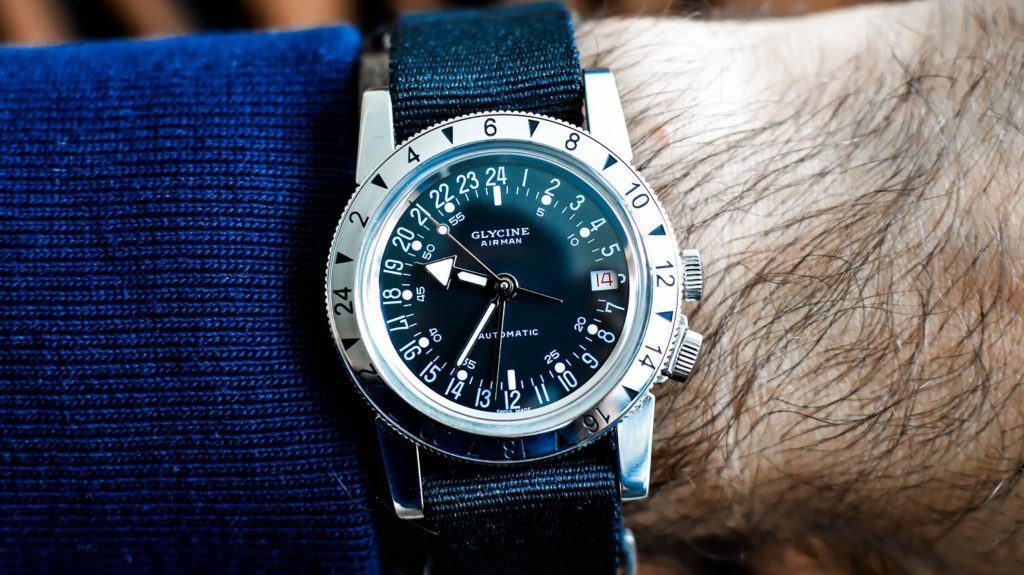
However, if you like the 24 hour dial and overall dial elements of the Glycine Airman No.1 but would prefer something with a bit less of a vintage design that was also simply larger (and more legible), I would highly encourage you to explore the Alpina Startimer Pilot Quartz Worldtimer (it’s 41mm in diameter, a whole 5mm larger than the Airman No.1).
Many credit the Invicta Watch Group’s acquisition of Glycine in 2016 with reviving the brand. However, this point in the brand’s history is a mystery to watch enthusiasts. Glycine models are still available, but there is little to virtually no marketing or outreach for the brand. This brand silence has led many to speculate whether the brand plans to remain active or explore other avenues.
Regardless, the Glycine Airman No.1 is a fantastic GMT watch option for anyone looking for a more vintage watch-wearing experience with all the convenience and reliability of modern craftsmanship. If you’d like to learn more, please read our piece covering the first release and resurgence of the Glycine Airman models. You can also check the official Glycine store and Gnomon watches if you’re interesting in purchasing this piece.
Archimede Pilot 42 GMT
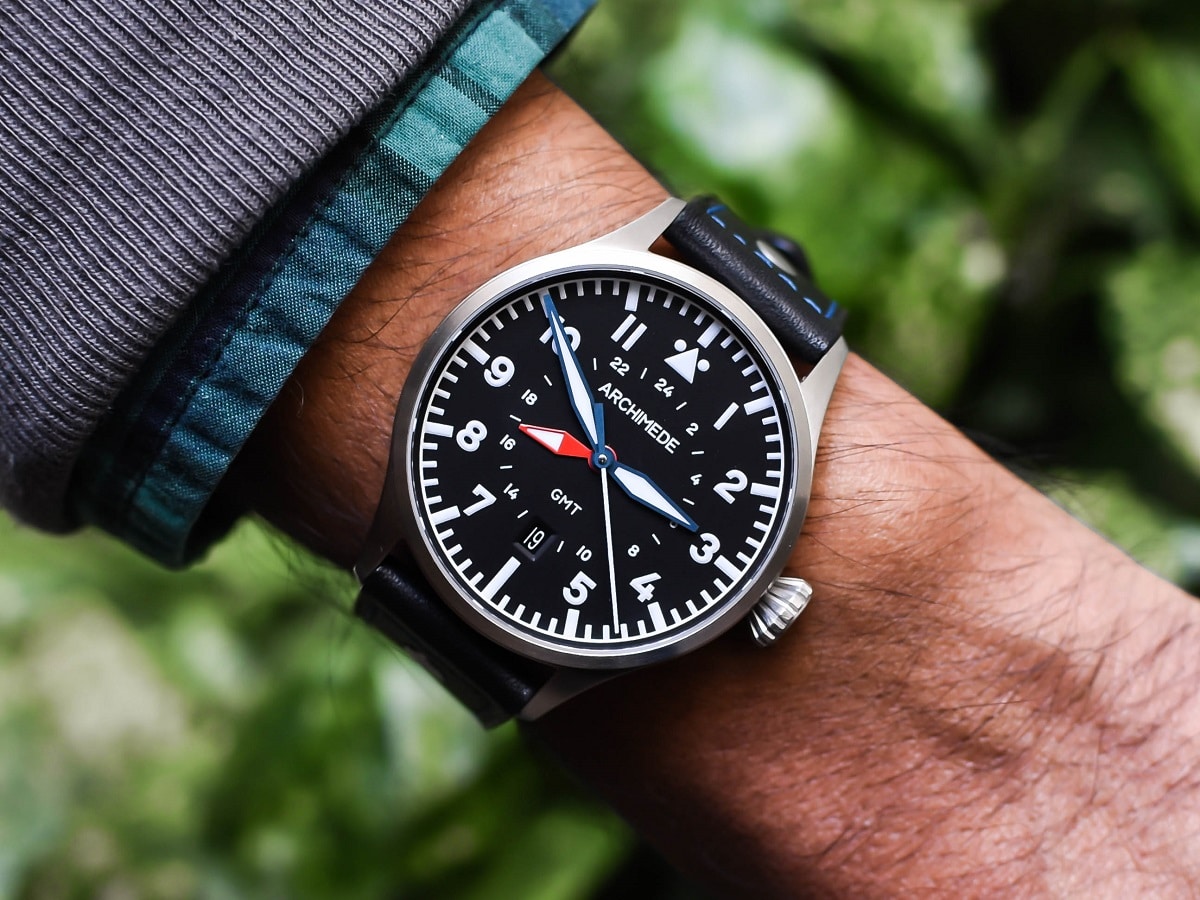
| Case Size: | 42mm x 51mm x 10.2mm |
| Movement: | Soprod C125 |
| GMT Type: | Caller GMT |
| Crystal: | Sapphire Crystal |
| Band Options: | Leather, Milanese Mesh, or Stainless Steel Bracelet |
| Price: | $1100 – $1300 |
In 1924, German-based watchmaker Karl Ickler started to craft high-quality watch cases for the burgeoning German watch brand industry. While the original factory he operated out of was destroyed by Allied forces in 1947, Karl Ickler’s sons led a rebuilding effort, and the production of watch cases continued into the early 2000s.
Around that time, the company started experimenting with creating their own watch brand. Then, in 2003, they started Archimede watches. Very quickly, the brand began to gain recognition as a producer of high-quality and affordable German timepieces – especially Fliegers. While the brand offers several different types of Flieger models, the Archimede Pilot 42 GMT is the focus of our discussion here.
I first encountered this product during a watch fair where Archimede had a booth set up. This was honestly one of the few times in my life where I tried a watch on and immediately thought “I need to buy this.” I suppressed the urge and opted instead to borrow the watch for some time to test it and gather my thoughts.
At 42mm in diameter and 51mm lug to lug, the watch may appear to wear large when looking at the specs, but the fantastic thinness of the case at 10.2mm curbs any top-heavy wearing experience one may expect. Instead, what occurs is a watch that covers an appropriate amount of surface area on your wrist to maximize legibility without feeling bulky. This wearing experience is what immediately drew me to the watch when I first tried it on. Personally for me, Flieger style watches aren’t a large draw, but this is the one Flieger that I constantly think about purchasing.
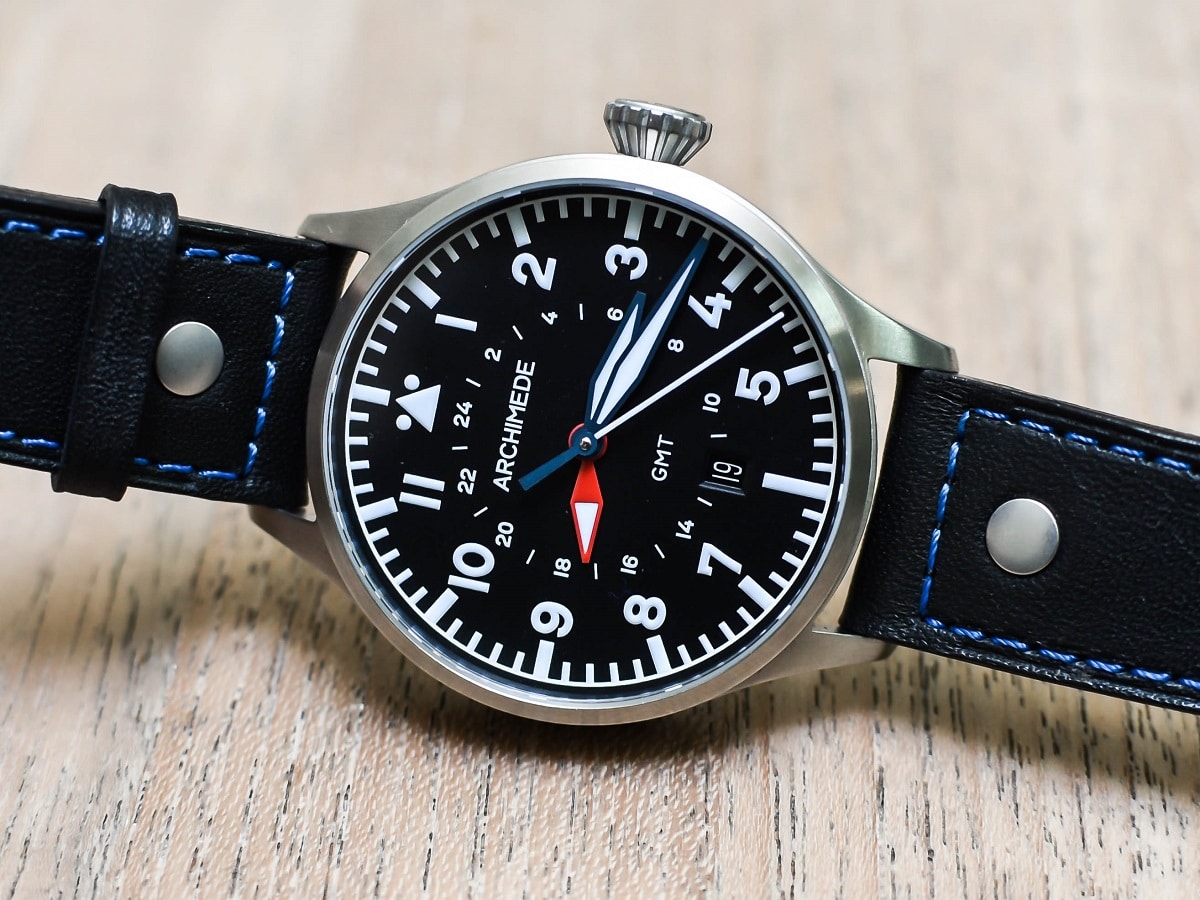
What’s most noteworthy about the Pilot GMT 42 and why it’s included in our list here is that it’s achieved something that seems relatively simple but I haven’t seen another brand execute as successfully as Archimede: naturally incorporating a GMT function on a historically accurate Flieger. Most other classic Flieger examples in this same size range like Laco Augsburg 42 and the Stowa Flieger versus 42 don’t have as naturally integrated GMT functions as the Archimede Pilot 42.
However, if you like the idea of an Aviation inspired dial design but maybe feel that the Archimede Pilot 42 is too vintage-inspired, you could look at the Laco Frankfurt GMT. It features an interior rotating 24 hour bezel, classic Flieger pilot hands and font, and a refreshed design that’s about 80% modern and 20% vintage. It also has a bit more color in the design, which is something that the Archimede Pilot 42 GMT is lacking. However the Laco Frankfurt GMT a bit more expensive at approximately $1900 versus the Archimede which ranges from $1200 – $1400.
As such, the wearing experience, relatively accessible price, and seamlessly designed GMT hand that still preserves that classic Flieger look make the Archimede Pilot 42 GMT an incredibly prospective purchase. You can learn more by reading our more in-depth, hands-on coverage of the Pilot 42 GMT. Plus, if you’re interested in purchasing the piece, you’ll find the official Archimede site to be the best place to do so.
Monta Atlas GMT Watch
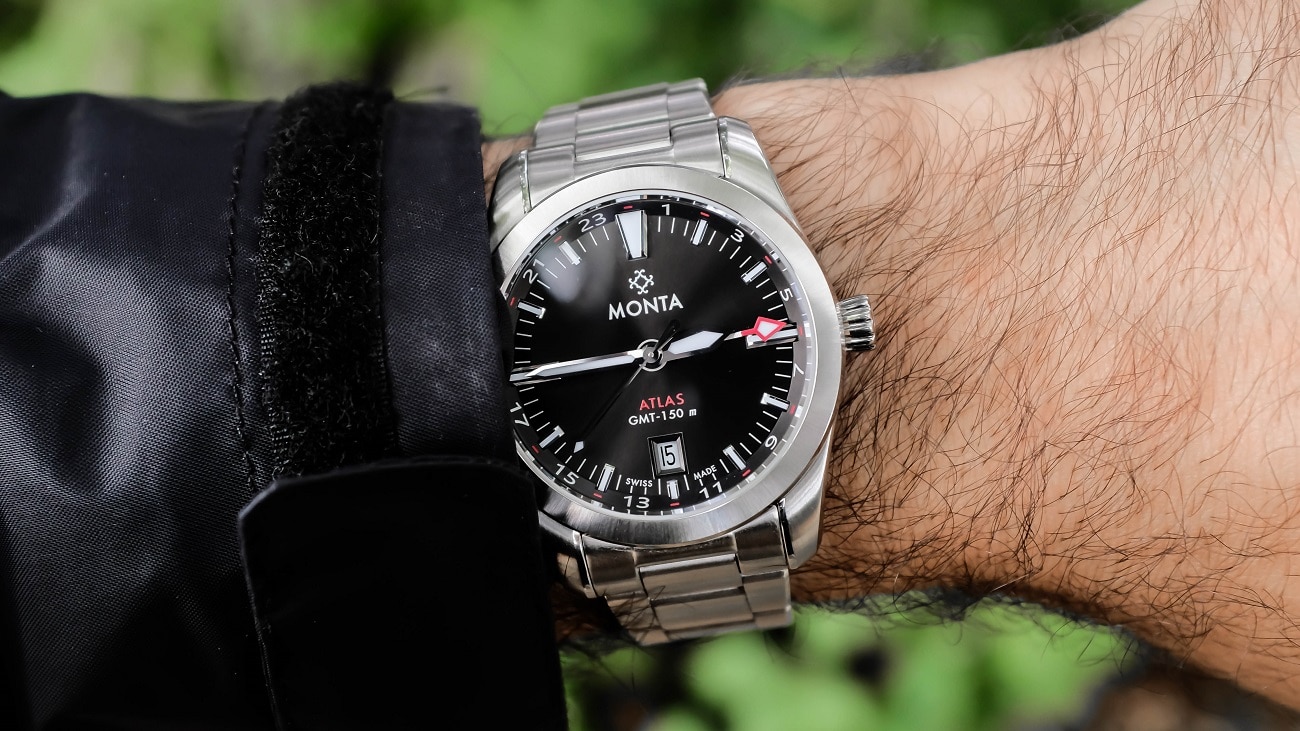
| Case Size: | 38.5mm x 47mm x 10.2mm |
| Movement: | MONTA Caliber M-23 (Mechanical) |
| GMT Type: | Caller GMT |
| Crystal: | Sapphire Crystal |
| Band Options: | Stainless Steel Bracelet |
| Price: | $1950 |
St. Louis-based Monta Watches is a brand that has expertly honed its design language and main value propositions. Combining equal parts timeless design, horological history, and modern technology, Monta has dedicated itself to creating timepieces that are more than the sum of their parts – case in point: the Monta Atlas GMT Watch.
The presentation of the Monta Atlas is easily one of the cleanest, function-driven, and non-frills GMTs I’ve ever seen. The balance between the hands and the dial elements creates an incredibly legible timepiece. There aren’t any design attempts to make this feel like a nostalgic aviation-driven GMT, nor is the watch attempting to capture people’s attention. Its design ensures a comfortable fit on your wrist while confidently functioning. There is nothing for this watch to attempt to compensate for when quality and form are its guiding principles.
In terms of dimensions, the Atlas GMT features a 38.5mm diameter case, 47mm lug to lug measurement, and a case thickness of 10.2mm. The evolution of the Atlas GMT is very closely aligned with that of two other core Monta offerings, the Noble and the Triumph. All three watches are essentially built of the same case design, diameter, and lug to lug measurement. However, the Atlas GMT differs from these other two by being .05mm thicker (where the Noble and the Triumph are 9.7mm thick). This slight variance in thickness is due to the Monta Caliber M-23 GMT movement (essentially a Sellita 330-1), which requires extra gears and parts in order to accommodate the GMT watch hand and making the movement thicker.

What I found most intriguing while I was wearing and testing the watch surprised me. In watch collection, the internet and social media is generally focused on getting you to zero in on dials. The dial is easily one of the best ways to visually merchandise and advertise a timepiece. However, while having the Atlas GMT on my wrist I realized in the first few moments that the dial was secondary to the bracelet. Nothing prepared me for how nicely finished the bracelet is. When I took the watch off and placed it on my desk or bedside table I would see how well articulated the links were as the watch sat as flat as possible when placed down. This degree of link articulation allowed the watch to conform so comfortably on my wrist that it was all I would really tell people about. The dial, GMT movement, and everything else took a backseat to the bracelet. As it should in my opinion.
The brand invested a lot of time and resources in ensuring that its unique bracelet achieved two things: it was as comfortable as possible and featured the absolute best fit and finish achievable. But what stands out the most about the Monta bracelet is that it’s incredibly visually nondescript. Only the wearer of the watch (and those in the know) would be aware of how special it was. But that’s the point with Monta. They command a higher price tag, but it’s also one of the rare instances where we will tell people it’s worth it. They aren’t trying to compete for people’s attention with flashy timepieces but to let the high-quality wearing experience speak for itself.
If you like the idea of a GMT watch like that Monta Atlas that doesn’t have a bezel but maybe aren’t too excited by the Monta Atlas’ design, it’s worth looking at the Farer Lander GMT, which presents itself as a similarly sized and more casual GMT then the Atlas. It also has a bit more personality since it’s available in colors like teal and red. That’s actually a con for the Atlas, its color options are limited to blue, silver, or gray, which are generally very standard and somewhat forgettable color options.
Be sure to read our review on the Monta Atlas if you’d like to learn more and be sure to visit the official Monta Watches site if you’re interested in buying this piece.
Monta Skyquest
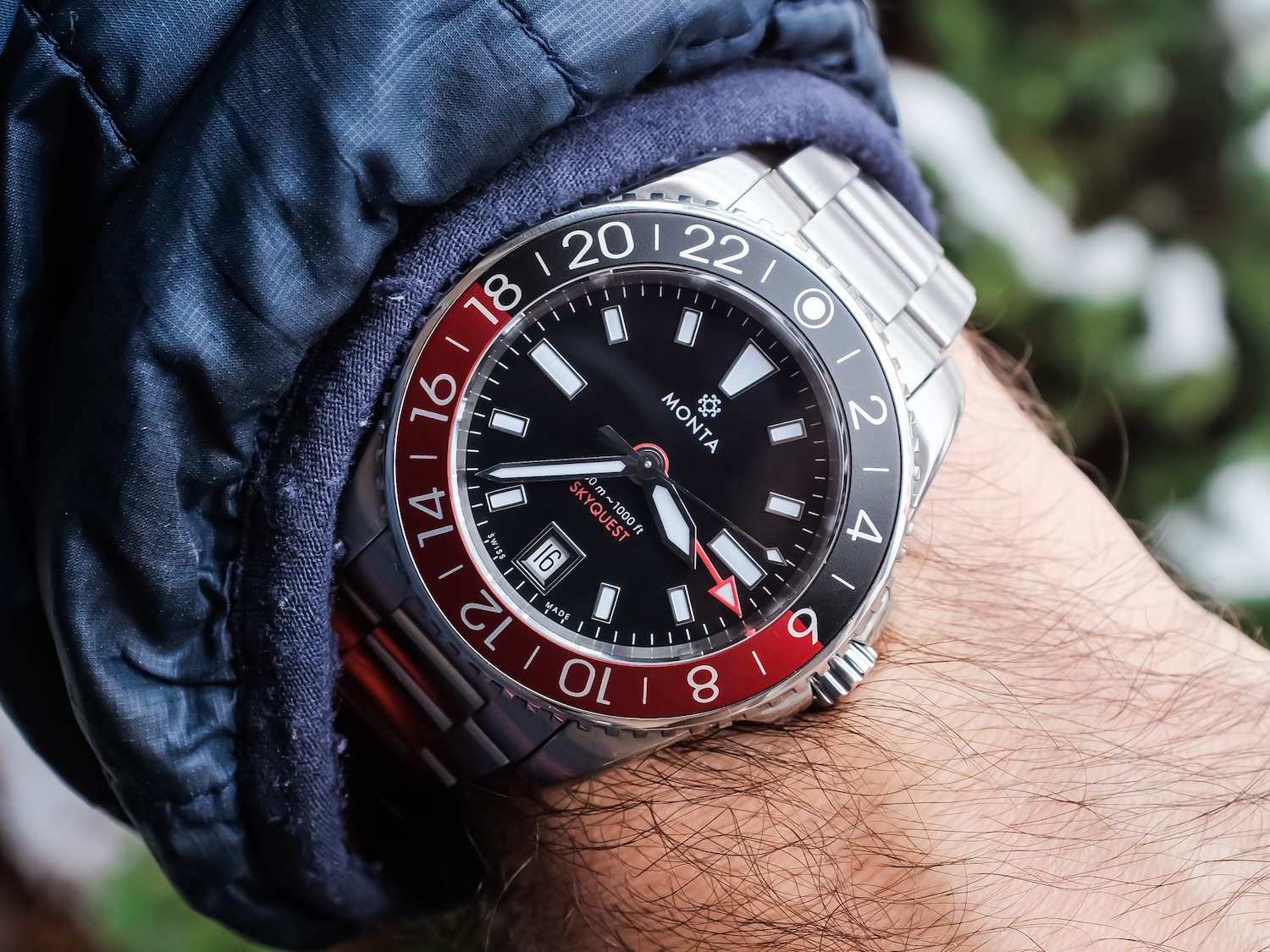
| Case Size: | 40.7mm x 47.4mm x 11.8mm |
| Movement: | MONTA Caliber M-23 (Mechanical) |
| GMT Type: | Caller GMT |
| Crystal: | Sapphire Crystal |
| Band Options: | Stainless Steel Bracelet |
| Price: | $2435 |
Monta has 5 product collections available, and two of those feature GMTs. So, it’s safe to say that the brand likes watches that track multiple time zones. However, when we zero in on the details, the Skyquest is a very different timepiece from the previous Monta we discussed.
At 40.7mm in diameter, the Skyquest’s case is larger than the Atlas and may appear visually bulkier due to the bezel, but it is certainly not too large to be comfortable. This is especially true since the previous generation’s lug to lug measurement was 49mm and this current generation’s lug to lug is measuring at a very wearable 47.4mm.
Whenever I did quick wrist glances while wearing the watch to check the time I was always surprised by how strong the legibility was versus how small, and wearable the overall watch felt. That’s also regardless of how and where I wore the watch. For example I had it on over the weekend while playing with my son and then later in the week I had to wear it with more business casual clothes. The Monta Skyquest had the same wearability, legibility, and classic design to seamlessly complement whatever outfit I was wearing and whatever I was doing.
The extra size is designed to support extra function. The indices are bolder, the crown guard is more stout, and this timepiece features a rotating GMT bezel, which allows the user to track an additional time zone (up to three). Plus, like all Monta releases, the Skyquest features their incredible bracelet which is crafted for optimal comfort, usage, and functionality. What I had heard some other people mention is that it’s possible you may find the bezel width a bit too wide for the watch, which can impact dial visibility and legibility.
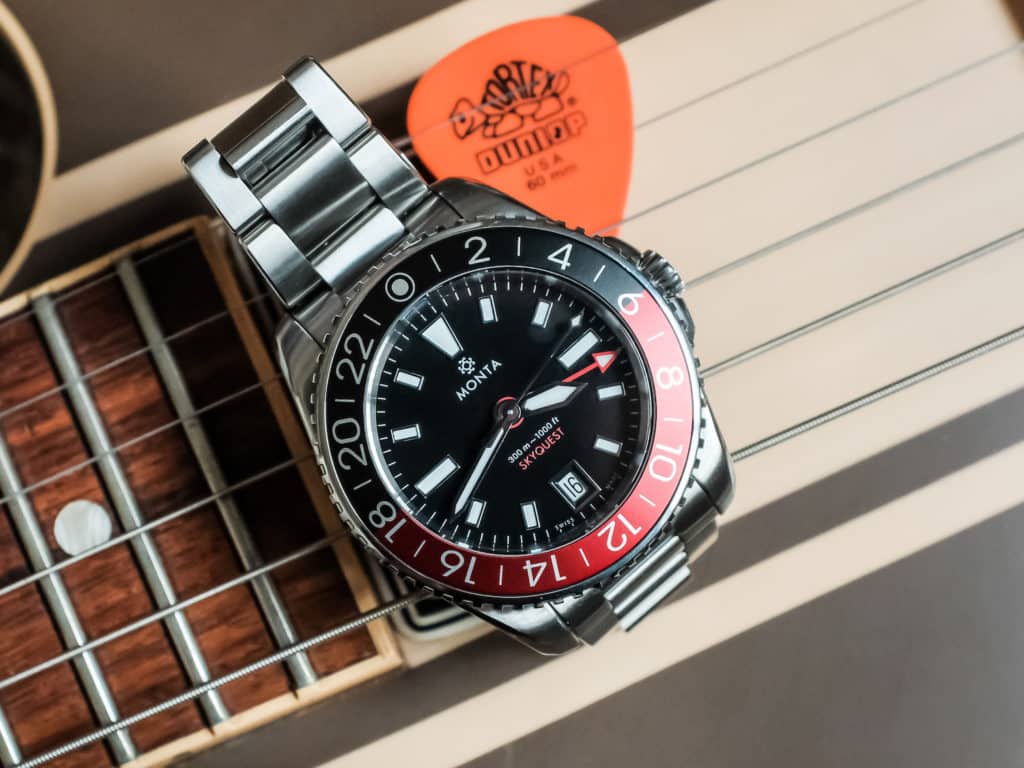
I only experienced this once when I needed to pull my hoodie sleeve back to see the time and my eye immediately focused on the bezel as opposed to the dial, which caused a slight millisecond delay in dial legibility. However, after it only happened once, I never had it happen again because I had acclimated to the watch. But if the visual balance between the bezel and the dial is something you’ve historically struggled with, it’s worth keeping in mind when considering the Skyquest. What’s interesting though and worth noting is that the previous generation Skyquest bezel actually had a slightly smaller font. So the decision to make the font larger was a conscious one.
The Skyquest is Monta’s answer to those looking for more of a historically aviation-inspired GMT watch. Between the sizing, options for a very legible GMT bezel, and dial colors, this would be the ideal choice for someone who wanted to experience Monta’s dedication to quality and excellence but still with a timepiece that was reminiscent and familiar within the catalog of GMT watch designs.
Now if you like the look of the Skyquest but aren’t quite sold on the $2500 price tag, you could consider the Vaer G5 Meridian, a 39mm Pepsi bezel GMT with a very similar dial layout, hour hand, and minute hand as the Skyquest but with a slightly less distracting bezel size and a much lower price tag of $900. On the other side of the price spectrum, if you wanted to spend more and get a Pepsi bezel GMT from a legacy Swiss brand, you could always look at the Tudor Black Bay GMT. It features the iconic Tudor snowflake hands, a slightly larger case at 41mm, and a price tag of approximately $4500 (learn more on our Black Bay GMT Review).
But what I’ll say is this. The Monta Skyquest for the price, is truly one of the most “one watch contender” pieces I’ve ever encountered. The price you pay for the quality you get and the timeless design that you get to enjoy is incredibly hard to beat.
If you’d like to research this timepiece further, please see our full review of the Skyquest and remember that the best place to purchase the Skyquest is directly from Monta.
Helpful GMT Watch Terminology To Know
Caller GMT
A Caller GMT is a type of watch where the additional 24-hour hand can be moved independently from the other hands on the dial. This function is crucial to maintain the local time that the wearer is tracking with the traditional hour and minute hands.
Anyone needing to track a second time zone for work or personal reasons typically uses Caller GMT, regardless of location. So if your location is in New York (ET GMT-5) but you do business or have family in Zurich (CET GMT +1), which is 6 hours ahead (the point difference between GMT -5 and GMT +1 is 6 points), you should set the 24-hour hand six hours ahead of the local time hour hand.
Traveler GMT
Often called a “True” GMT watch, the Traveler GMT essentially utilizes the opposite practice from the Caller GMT to track dual time. You can set the hour hand independently from the minute hand.
This function exists because the wearer uses the timepiece as a travel watch and consistently changes time zones. In doing this, they need the ability to move the main hour hand to alter their local time on the fly. Typically, people set the additional 24-hour hand to their home time zone.
GMT Rotating Bezel
Some GMT watches will include a bidirectional rotating bezel with a 24-hour scale. This is a GMT bezel the wearer uses to track additional time zones on demand. The principle works like this – the GMT hand functions as the central reference point.
If we’re wearing a Traveler GMT watch and want to track time in the CET (GMT+1) time zone, we can use the GMT 24-hour bezel to make the necessary adjustment. Assuming our local time is on the East Coast (GMT-5), and we know that CET is 6 hours ahead of our home time, we need to move the bezel six clicks to the left. This action will align our local time hand with the CET time zone (GMT+1).

Co-Founder and Senior Editor
Kaz has been collecting watches since 2015, but he’s been fascinated by product design, the Collector’s psychology, and brand marketing his whole life. While sharing the same strong fondness for all things horologically-affordable as Mike (his TBWS partner in crime), Kaz’s collection niche is also focused on vintage Soviet watches as well as watches that feature a unique, but well-designed quirk or visual hook.
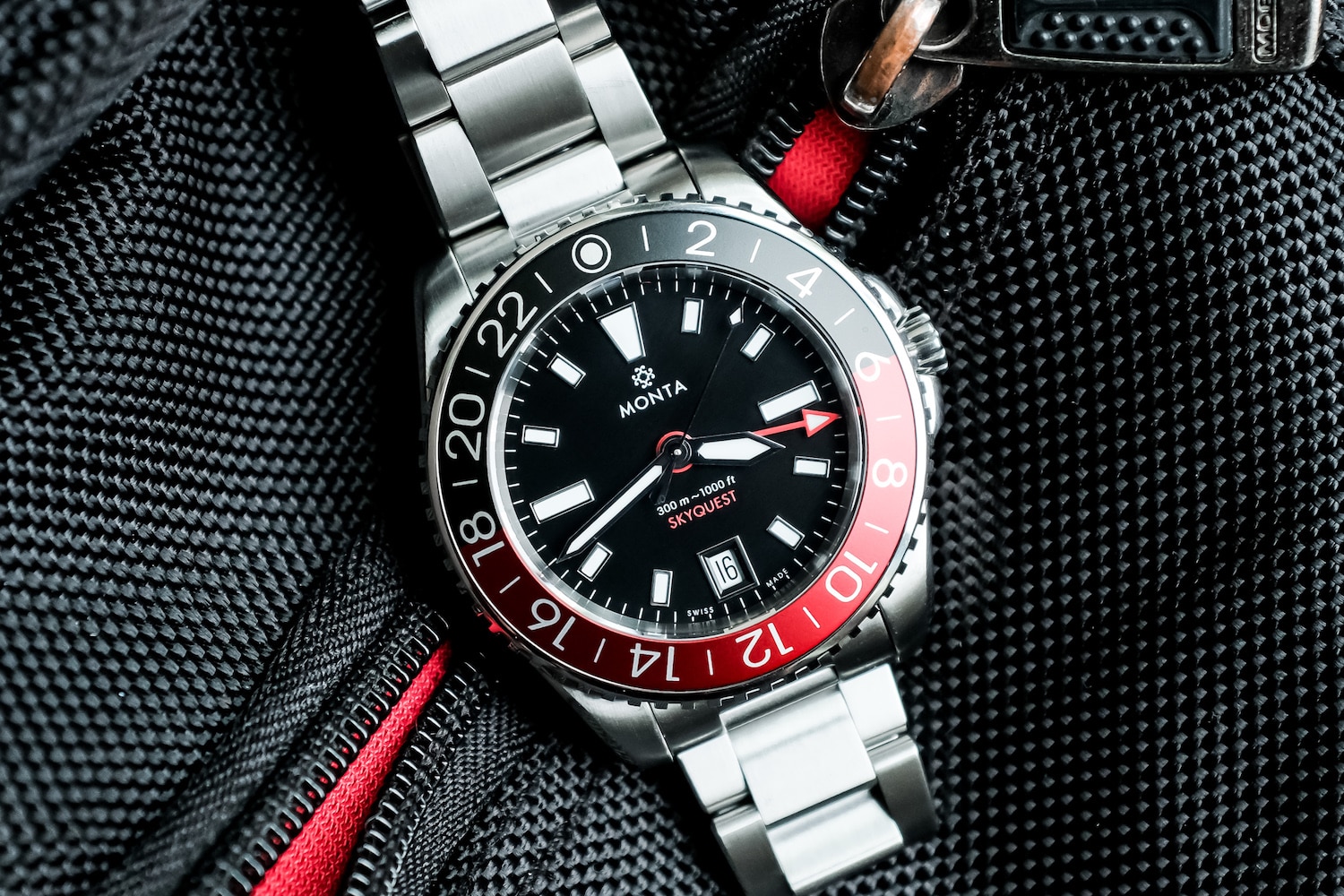
I have a Lum Tec Combat B45 GMT (caller style) and am fond of it. For the price, the finish and everything about it is quite nice. I am quite sure that I could run it over with my car and it would be just fine, which is why I bought it. Well kind of. I do not plan on running it over but I have absolutely not treated it nicely and it is just fine.
I propose a watch from a major brand, multiple time zones, easy to set hands, divers bezel and when there is almost no budget. Timex T45181. I travel almost every 2 weeks for work. I wanted that feeling of being connected to my home time zone that you discussed in a recent podcast. I’m wary of Amazon brands that disappear, or others that sound too good to be true. Unless that $500+ GMT watch comes with many giant boxes of diapers, it was not happening. The Casio multi time zone options didn’t seem to have easy to set hands. So I bought the Timex. I’m hoping it will be that unicorn of reliability, features, and feeling of being connected to my family at home. I actually plan on using the ability to time with the bezel often. Maybe if it’s successful after a few trips I will upgrade the watch band.
Hi Mike and Kaz, the GMT episode was great! In response to the call for feedback on some other budget friendly GMT options, I submit some that I own for consideration:
1. Citizen Nighthawk – a “traveler” GMT with a fun an unique GMT hand/display.
2. Seiko SNJ029 and related models – the “Arnie” and “Safarnie” can display a separate time in the digital display.
3. A less well known but longstanding microbrand, Bernhardt, has a couple of fun GMT options including the one that I own (with the green and silver bezel) the Corsair GMT (formerly known as the Globemaster).
Keep up the great work!!!
What about the Monta Atlas that slides right under your $2000 cap. From all accounts Monta is offering watches hitting way above their weight class.
VERY disappointing feature. Why are they ALL caller GMT’s. I would suggest that many people who like watches and travel frequently as I do really only want TRAVELLER GMT’s – reviewers don’t really appreciate why this is for a watch enthusiast and I’ll explain now – in ADDITION to the fact that just jumping the hour hand makes it super easy to change the time according to time zone forwards or back – we HATE to interfere with the minute hand because often it’s nicely set up so that it synchronizes perfectly with the second hand – ok that’s a geeky thing but i personally like the minute hand to sync accurately with the second hand and I really don’t want to touch it after it’s correctly set AND once I know how my performance behaves – I regulate mine to gain the ONLY thing I want to do is occasionally hack the seconds to let the real time catch up with the watch time – I might cross time zones 2-3 times in 1 month I don’t want pkay with the minute hand.
The Glycine Airman is actually a “true”/”traveler” GMT if you set it up as intended: with GMT on the main dial and local time on the outer bezel. Since GMT remains constant, you never need to interfere with either the hour or minute hand, simply adjust the bezel forward or backward as needed to display local time and lock it in place.
Hi, Eeyore:
Excellent point and great observation! I do think that there is certainly more education within the watch community that needs to happen around GMT bezels. When used correctly as you’ve stated, they’re effective at allowing you to leverage maximum usability out of your GMT.
Best,
-Kaz